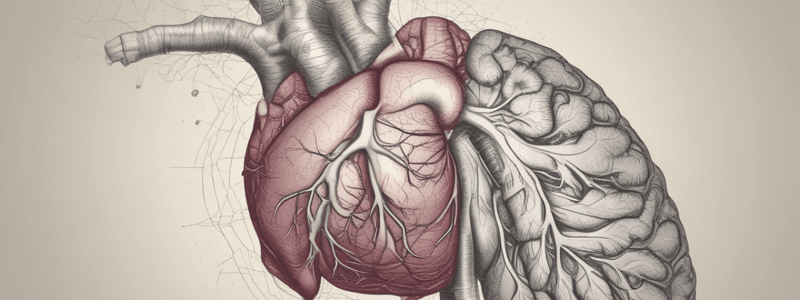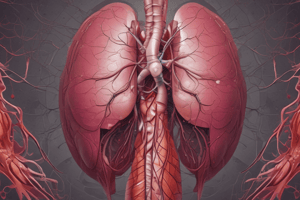Podcast
Questions and Answers
What percentage of the liver's blood supply is from the hepatic artery and vein?
What percentage of the liver's blood supply is from the hepatic artery and vein?
- 25% (correct)
- 100%
- 50%
- 75%
What is the function of Kupffer cells in the liver?
What is the function of Kupffer cells in the liver?
- Store bile
- Phagocytose aged erythrocytes (correct)
- Regulate blood pressure
- Digest proteins
What are the two additional lobes on the right side of the liver?
What are the two additional lobes on the right side of the liver?
- Right and left
- Accessory and pyramidal
- Falciform and triangular
- Caudate and quadrate (correct)
What is the function of the hepatic portal vein?
What is the function of the hepatic portal vein?
What is the name of the ligament that attaches to the anterior surface of the liver?
What is the name of the ligament that attaches to the anterior surface of the liver?
What is the shape of the gallbladder?
What is the shape of the gallbladder?
What are the three parts of the gallbladder?
What are the three parts of the gallbladder?
Where is the gallbladder located?
Where is the gallbladder located?
Which of the following is NOT a characteristic of the esophageal histology?
Which of the following is NOT a characteristic of the esophageal histology?
Which of the following is a correct anatomical feature of the stomach?
Which of the following is a correct anatomical feature of the stomach?
Which of these structural features distinguishes the duodenum from the other parts of the small intestine?
Which of these structural features distinguishes the duodenum from the other parts of the small intestine?
What is the primary function of the pancreas?
What is the primary function of the pancreas?
Which of the following structures is NOT part of the liver's functional unit, the hepatic lobule?
Which of the following structures is NOT part of the liver's functional unit, the hepatic lobule?
Which of the following arteries supplies blood to the stomach?
Which of the following arteries supplies blood to the stomach?
What type of cells are responsible for producing hydrochloric acid (HCl) in the stomach?
What type of cells are responsible for producing hydrochloric acid (HCl) in the stomach?
Which of the following is NOT a function of the pancreas?
Which of the following is NOT a function of the pancreas?
What is the primary function of the circular folds (plicæ circulares) in the duodenum?
What is the primary function of the circular folds (plicæ circulares) in the duodenum?
Which of the following statements about the duodenum is TRUE?
Which of the following statements about the duodenum is TRUE?
What is the main function of the mucous cells in the gastric pits?
What is the main function of the mucous cells in the gastric pits?
Which of the following is a characteristic of the esophagus?
Which of the following is a characteristic of the esophagus?
What are the two main lobes of the liver?
What are the two main lobes of the liver?
Why is the accessory duct in the pancreas important?
Why is the accessory duct in the pancreas important?
Flashcards are hidden until you start studying
Study Notes
Liver
- The liver has four lobes: right, left, caudate, and quadrate
- Ligaments of the liver include:
- Falciform ligament
- Coronary ligament (anterior and posterior folds)
- Triangular ligaments (left and right)
- Lesser omentum
- The liver has a dual blood supply:
- Hepatic artery and vein (25%): oxygenation
- Hepatic portal vein (75%): main blood supply to the liver conveying absorbed nutrients from the small and large bowel
- Histology of the liver:
- Polygonal hepatic lobules: basic functional units of the organ
- Periphery of the hexagon has three structures known as the portal triad
- Direction of bile flow is opposite to blood
- Bile canaliculi: smallest branches of the biliary tree
- Stellate macrophages (Kupffer cells): phagocytose aged erythrocytes
Biliary Ducts and Gallbladder
- Extrahepatic bile passages and pancreatic ducts:
- Sphincter of bile duct
- Sphincter of pancreatic duct
- Hepatopancreatic sphincter
- The gallbladder:
- Intraperitoneal, pear-shaped sac
- Location: fossa between the inferior aspects of the right and quadrate lobes of the liver
- Storage capacity: 30-50ml
- Three parts: Fundus, Body, and Neck
Spleen
- Location:
- Diaphragmatic surface and visceral surface
- Internal features:
- Gastric pits have mucous cells that produce mucous to protect the inner lining of the stomach
- Gastric glands are lined by Parietal cells (HCl), Chief cells (pepsinogen and chymosin), and Enteroendocrine cells (local hormones)
- White blood cells stored in spleen/ recycles old red blood cells
- Goblet cells = mucous prod.
Duodenum
- Location:
- Retroperitoneal
- C-shaped, four parts
- Internal features:
- Superior (1st) part: no circular folds
- Other parts: circular folds (plicæ circulares, valves of Kerkring) that slow the passage of food along the small intestines
Pancreas
- Location:
- Retroperitoneal except at the tail
- Internal features:
- Exocrine pancreas: produces digestive enzymes
- Endocrine pancreas: produces hormones (Glucagon, insulin, and somatostatin)
Blood Supply
- Coeliac trunk branches:
- Common hepatic artery
- Right gastric artery
- Gastroduodenal artery
- Right gastro-omental artery
- Left gastric artery
- Splenic artery
- Left gastro-omental artery
- Short gastric arteries
- Dorsal pancreatic artery
- Inferior pancreatic artery
Nerve Supply
- Innervation:
- Foregut receives innervation from the autonomic nervous system:
- Parasympathetic innervation: Vagus nerve
- Sympathetic supply: T5-T9 spinal cord segments
- Foregut receives innervation from the autonomic nervous system:
Studying That Suits You
Use AI to generate personalized quizzes and flashcards to suit your learning preferences.




